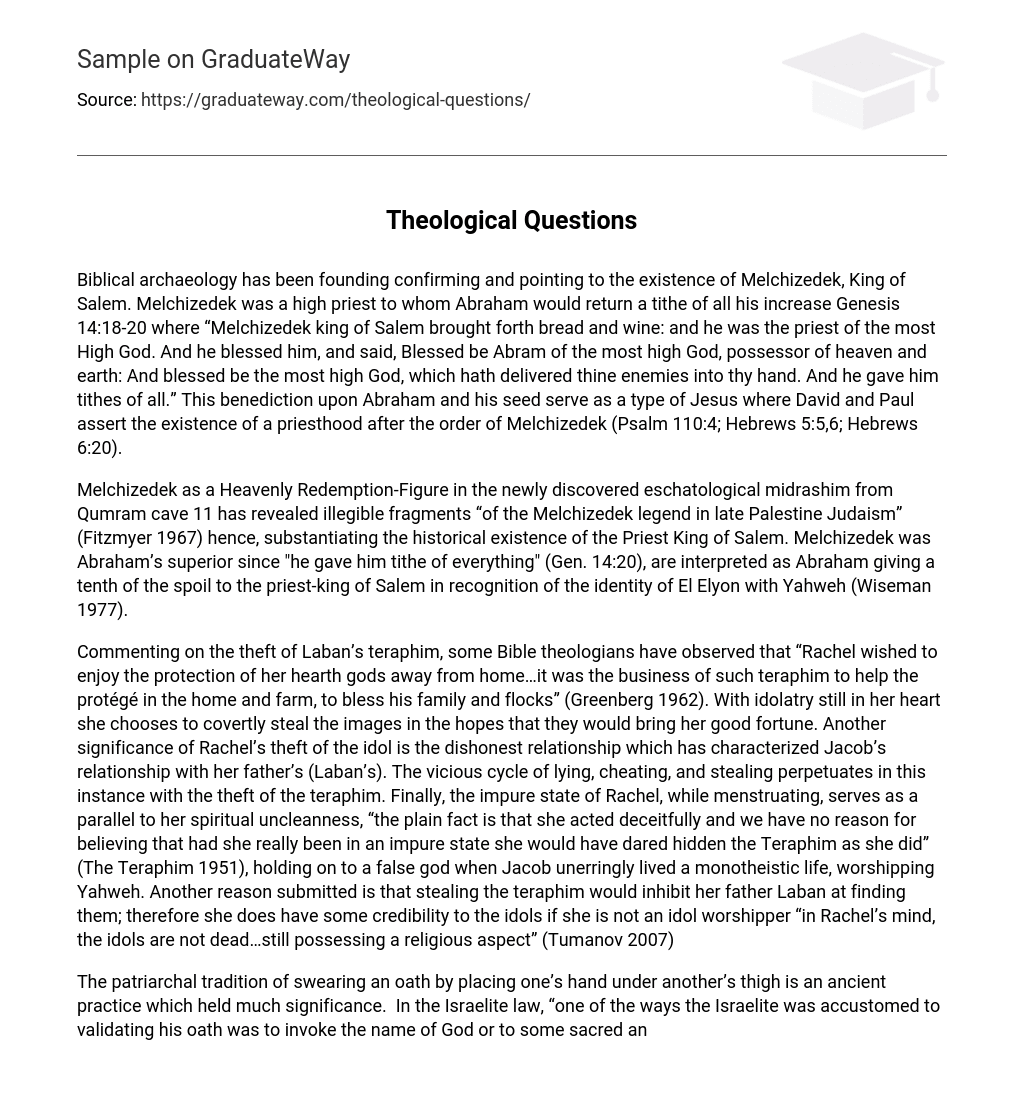Biblical archaeology has been founding confirming and pointing to the existence of Melchizedek, King of Salem. Melchizedek was a high priest to whom Abraham would return a tithe of all his increase Genesis 14:18-20 where “Melchizedek king of Salem brought forth bread and wine: and he was the priest of the most High God. And he blessed him, and said, Blessed be Abram of the most high God, possessor of heaven and earth: And blessed be the most high God, which hath delivered thine enemies into thy hand. And he gave him tithes of all.” This benediction upon Abraham and his seed serve as a type of Jesus where David and Paul assert the existence of a priesthood after the order of Melchizedek (Psalm 110:4; Hebrews 5:5,6; Hebrews 6:20).
Melchizedek as a Heavenly Redemption-Figure in the newly discovered eschatological midrashim from Qumram cave 11 has revealed illegible fragments “of the Melchizedek legend in late Palestine Judaism” (Fitzmyer 1967) hence, substantiating the historical existence of the Priest King of Salem. Melchizedek was Abraham’s superior since “he gave him tithe of everything” (Gen. 14:20), are interpreted as Abraham giving a tenth of the spoil to the priest-king of Salem in recognition of the identity of El Elyon with Yahweh (Wiseman 1977).
Commenting on the theft of Laban’s teraphim, some Bible theologians have observed that “Rachel wished to enjoy the protection of her hearth gods away from home…it was the business of such teraphim to help the protégé in the home and farm, to bless his family and flocks” (Greenberg 1962). With idolatry still in her heart she chooses to covertly steal the images in the hopes that they would bring her good fortune. Another significance of Rachel’s theft of the idol is the dishonest relationship which has characterized Jacob’s relationship with her father’s (Laban’s). The vicious cycle of lying, cheating, and stealing perpetuates in this instance with the theft of the teraphim. Finally, the impure state of Rachel, while menstruating, serves as a parallel to her spiritual uncleanness, “the plain fact is that she acted deceitfully and we have no reason for believing that had she really been in an impure state she would have dared hidden the Teraphim as she did” (The Teraphim 1951), holding on to a false god when Jacob unerringly lived a monotheistic life, worshipping Yahweh. Another reason submitted is that stealing the teraphim would inhibit her father Laban at finding them; therefore she does have some credibility to the idols if she is not an idol worshipper “in Rachel’s mind, the idols are not dead…still possessing a religious aspect” (Tumanov 2007)
The patriarchal tradition of swearing an oath by placing one’s hand under another’s thigh is an ancient practice which held much significance. In the Israelite law, “one of the ways the Israelite was accustomed to validating his oath was to invoke the name of God or to some sacred and powerful substitute” (Greensburg 1957). Eleazar placed his hand upon the thigh of Abraham, while swearing to follow his directives in finding a wife (Genesis 24:2) and Jacob has Joseph swear to him (Genesis 49: 29). Not any hand was placed under the thigh, it had to be the right hand since “the right hand was more important as a means of affirmation” (Falk 1959). The right hand is the primary hand the bespeaks preference in selection since fathers would also place the right hand on the head of the chosen firstborn (Genesis 48:13). Moreover, the thigh oath was a “covenant ceremony…in which the …placing a hand under the thigh in order to indicate an intimate loyalty, self-sacrifice, deference or commitment” (Beacham 2009). God takes oaths and covenants seriously since He is a covenant-keeping God therefore, this act of swearing only mirrors godly principles of fidelity, intimacy, and truth.
References
Beacham, Roy E. The New Covenant of Scripture in a Covenant Context: A Preliminary Paper.
Council on Dispensational Hermeneutics. Central Baptist Theological Seminary, September 23, 2009.< http://www.bbc.edu/council/documents/Roy_Beacham_ANE-Covenants-and-NC.pdf>. Accessed 06 June 2010.
Falk, Zeev W. Gestures Expressing Affirmation. Journal of Semitic Studies 1959.University of
Manchester. < http://jss.oxfordjournals.org/cgi/pdf_extract/4/3/268>. Accessed 06 June 2010.
Fitzmyer, Joseph. Further Light on Melchizedek from Qumran Cave 11. Journal of Biblical
Literature, Vol. 86, No. 1 (Mar., 1967). The Society of Biblical Literature. <http://www.jstor.org/stable/3263241>. Accessed 06 June 2010.
Greenberg, Moshe. Another Look at Rachel’s Theft of the Teraphim. Journal of Biblical
Literature, Vol. 81, No. 3 (Sep., 1962), The Society of Biblical Literature, <http://www.jstor.org/stable/3264421>. Accessed 06 June 2010.
Greenberg, Moshe. The Hebrew Oath Particle Ḥay/Ḥē. Journal of Biblical Literature, Vol. 76,
No. 1 (Mar., 1957). The Society of Biblical Literature. <http://www.jstor.org/stable/3262129>. Accessed 06 June 2010.
The Teraphim. The Expository Times, Vol. 62, No. 12, 378-380 (1951).
<http://spext.highwire.org/cgi/pdf_extract/62/12/378 Accessed 06 June 2010.
Tumanov, Vladimir. Yahweh vs. the Teraphim: Jacob’s Pagan Wives in Thomas Mann’s
Joseph and his Brothers and in Anita Diamant’s The Red Tent.<http://www.iiav.nl/ezines/web/Nebula/2007/No4.2+3/nobleworld/Tumanov.pdf >. Accessed 06 . June 2010.
Wiseman, Donald. Abraham in History and Tradition-Part II: Abraham the Prince. Dallas
Theological Seminary. 1977.





